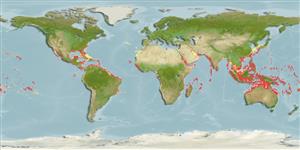Gastropoda |
Littorinimorpha |
Ranellidae | Cymatiinae
Environment: milieu / climate zone / Mức độ sâu / distribution range
Sinh thái học
; Mức độ sâu 0 - 60 m (Tài liệu tham khảo 83934). Tropical; 40°N - 24°S, 180°W - 180°E
Circumtropical: from Japan to Pitcairn Islands.
Length at first maturity / Bộ gần gũi / Weight / Age
Chín muồi sinh dục: Lm ? range ? - ? cm Max length : 12.0 cm ShH con đực/không giới tính; (Tài liệu tham khảo 349); common length : 8.0 cm SHL con đực/không giới tính; (Tài liệu tham khảo 349)
Locally collected for food and for the shell (Ref. 349). Common under coral slabs. Occurs at the low tide mark (Ref. 349). It is also found offshore, on coral reefs, cienaga facies, and mangroves, particularly on pilings, cirripeds, coral, mud, rock, sand, seagrass, and shell habitats (Ref. 83934).
Life cycle and mating behavior
Chín muồi sinh dục | Sự tái sinh sản | Đẻ trứng | Eggs | Sự sinh sản | Larvae
Members of the order Neotaenioglossa are mostly gonochoric and broadcast spawners. Life cycle: Embryos develop into planktonic trocophore larvae and later into juvenile veligers before becoming fully grown adults.
Poutiers, J.M. 1998 Gastropods. p. 363-648. In Carpenter, K. E. and V. H. Niem. 1998. FAO species identification guide for fishery purposes. The living marine resources of the Western Central Pacific. Volume 1. Seaweeds, corals, bivalves, and gastropods. Rome, FAO. (Tài liệu tham khảo 349)
IUCN Red List Status
(Tài liệu tham khảo 130435: Version 2025-1)
CITES status (Tài liệu tham khảo 108899)
Not Evaluated
CMS (Tài liệu tham khảo 116361)
Not Evaluated
Threat to humans
Human uses
| FishSource |
Các công cụ
Thêm thông tin
Life cycleSự tái sinh sảnChín muồi sinh dụcSự sinh sảnĐẻ trứngEggsEgg developmentLarvae PhysiologyThành phần ô-xy
Human RelatedStamps, coins, misc.
Các nguồn internet
Estimates based on models
Preferred temperature
(Ref.
115969): 24.8 - 29.3, mean 28.5 (based on 3310 cells).
Fishing Vulnerability
Low vulnerability (10 of 100).
Price category
Unknown.
